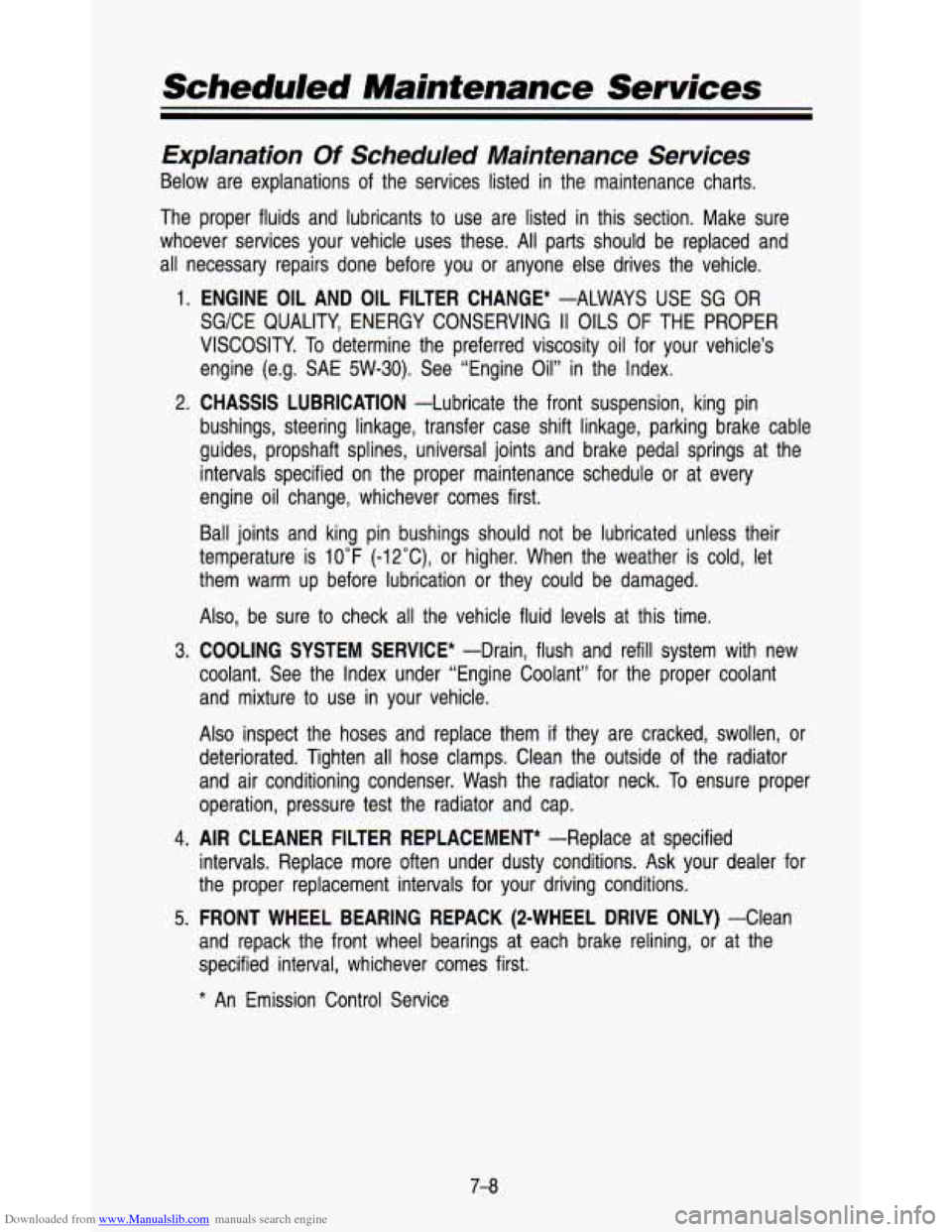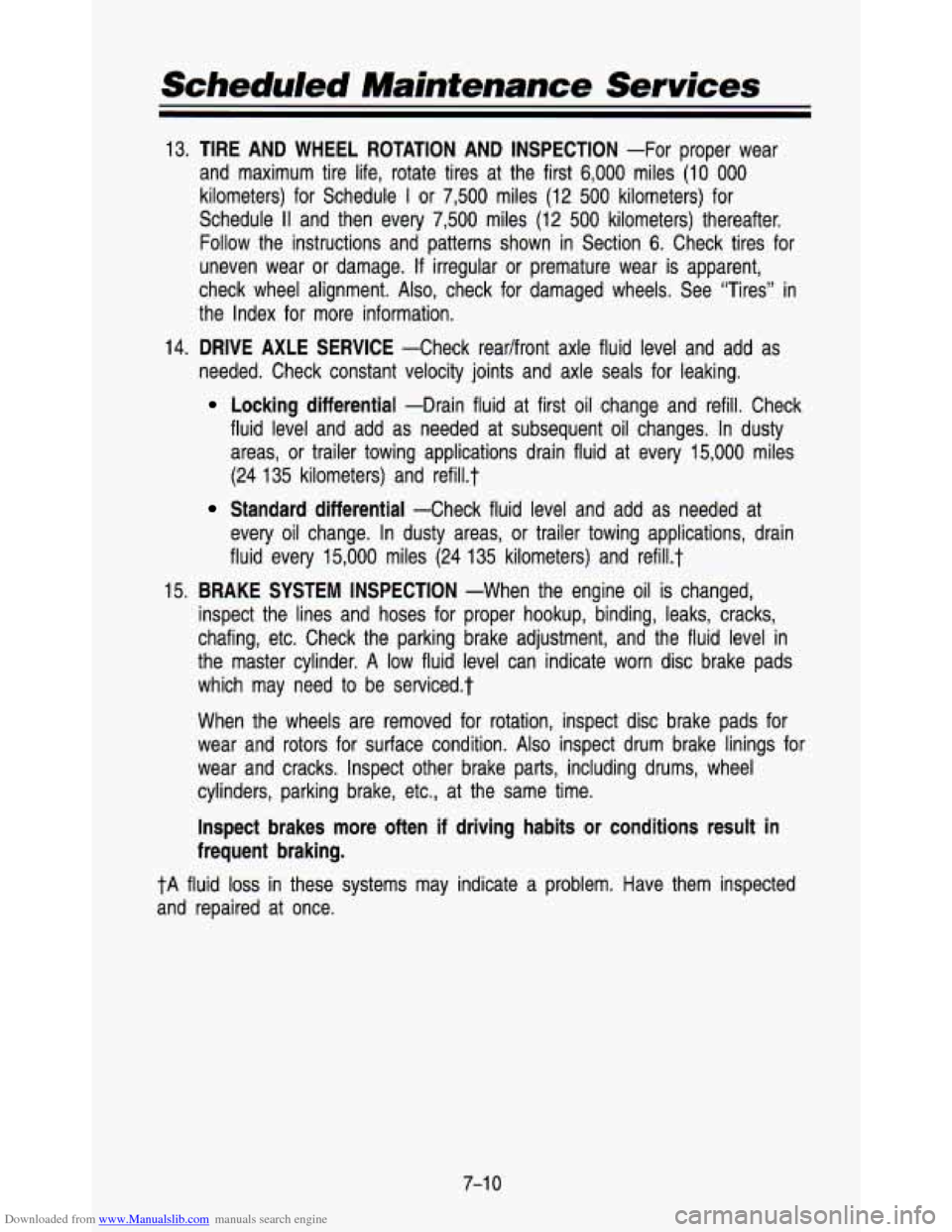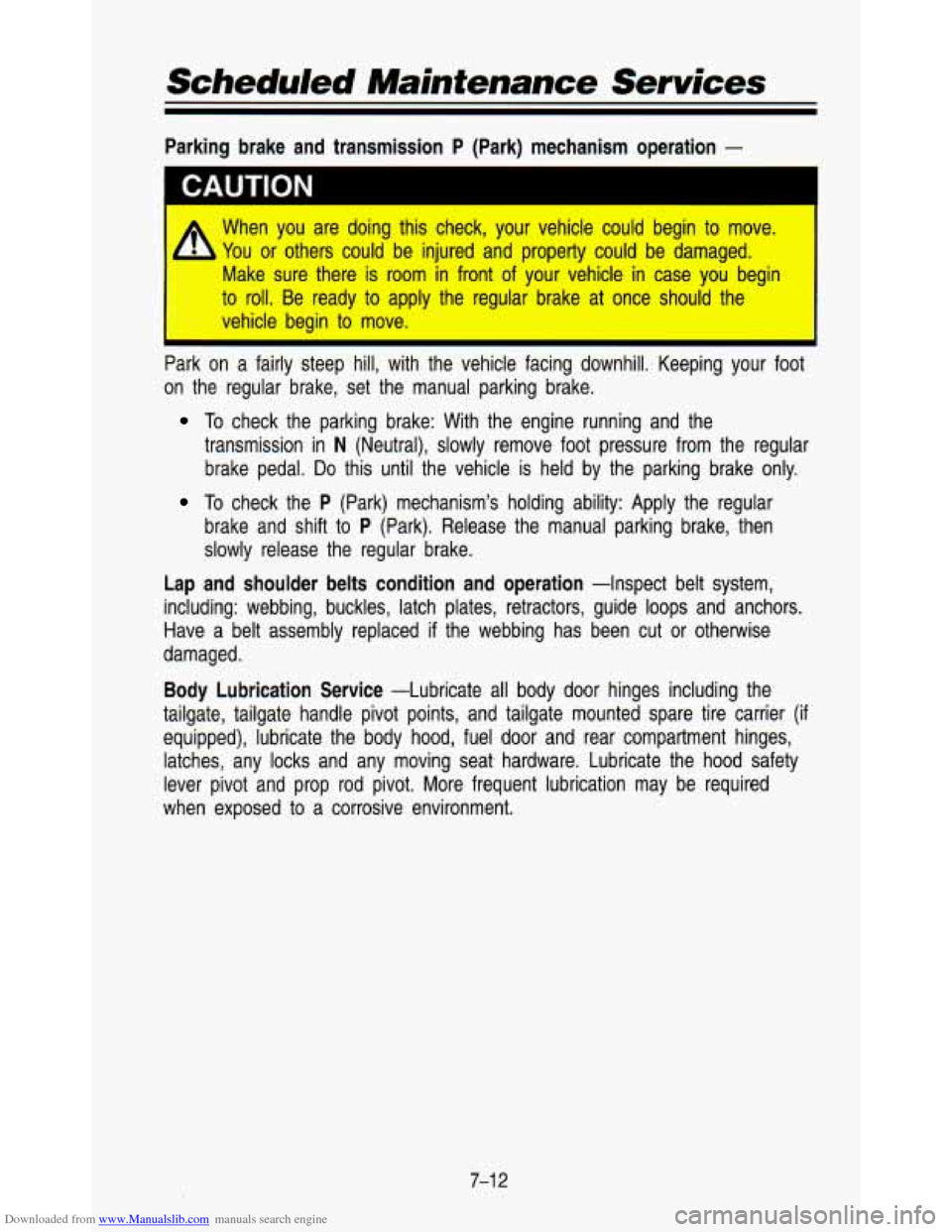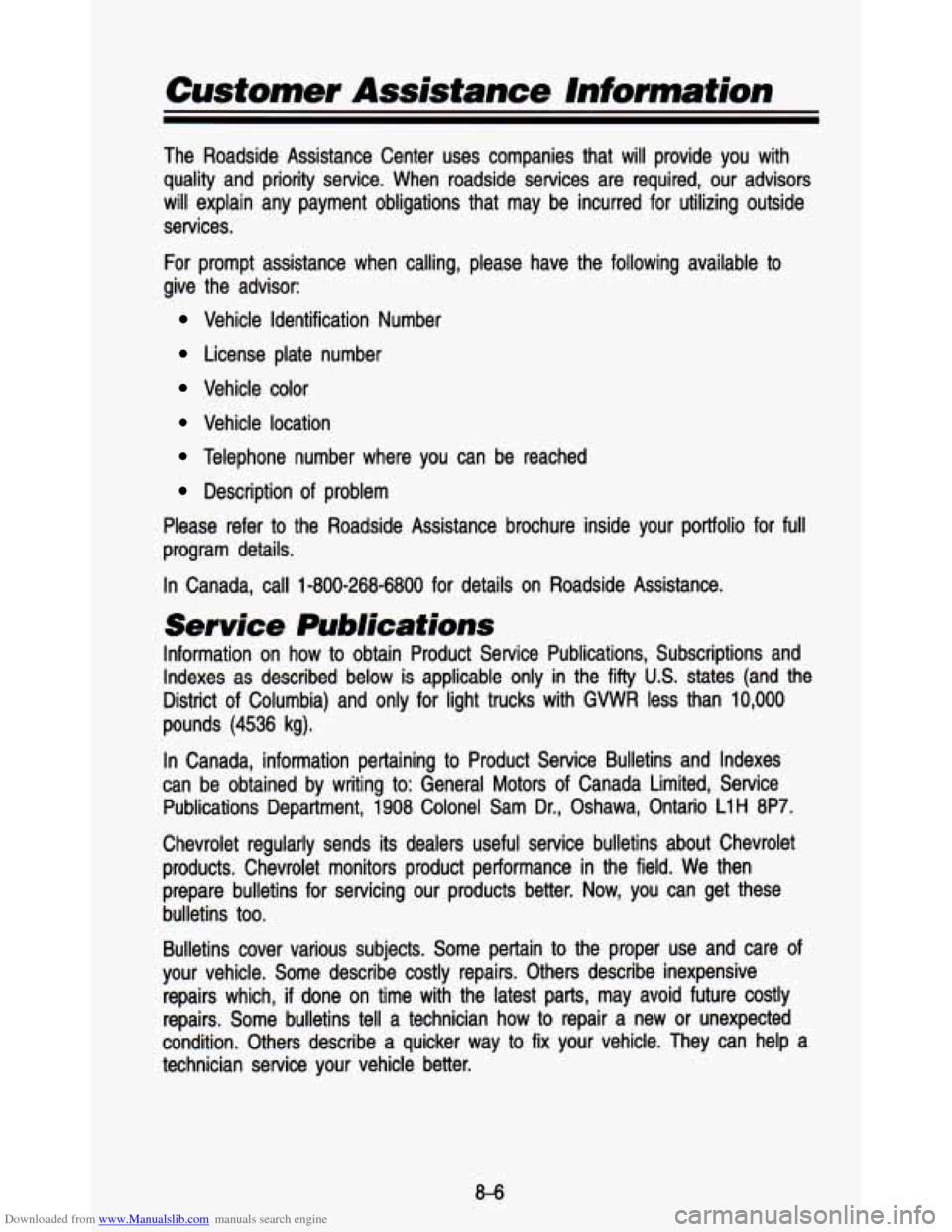1993 CHEVROLET ASTRO PASSENGER air condition
[x] Cancel search: air conditionPage 314 of 345

Downloaded from www.Manualslib.com manuals search engine Scheduled Maintenance Services
Explanation Of Scheduled Maintenance Services
Below are explanations of the services listed in the maintenance charts.
The proper fluids and lubricants to use are listed in this section. Make sure
whoever services your vehicle uses these. All parts should be \
replaced and
all necessary repairs done before you or anyone else drives th\
e vehicle.
1. ENGINE OIL AND OIL FILTER CHANGE* -ALWAYS USE SG OR
SG/CE QUALITY, ENERGY CONSERVING II OILS OF THE PROPER
VISCOSITY.
To determine the preferred viscosity oil for your vehicle’s
engine (e.g. SAE 5W-30). See “Engine Oil” in the Index.
bushings, steering linkage, transfer case shift linkage, parking \
brake cable
guides, propshaft splines, universal joints and brake pedal spri\
ngs at the
intervals specified on the proper maintenance schedule or at ev\
ery
engine oil change, whichever comes first.
2.
CHASSIS LUBRICATION -Lubricate the front suspension, king pin
Ball joints and king pin bushings should not be lubricated unl\
ess their
temperature is
10°F (-12”C), or higher. When the weather is cold, let
them warm up before lubrication or they could be damaged.
Also, be sure to check all the vehicle fluid levels at this time.
3.
COOLING SYSTEM SERVICE* -Drain, flush and refill system with new
coolant. See the Index under “Engine Coolant” for the pro\
per coolant and mixture to use in your vehicle.
Also inspect the hoses and replace them
if they are cracked, swollen, or
deteriorated. Tighten all hose clamps. Clean the outside of the radiator
and air conditioning condenser. Wash the radiator neck.
To ensure proper
operation, pressure test the radiator and cap.
4. AIR CLEANER FILTER REPLACEMENT* -Replace at specified
intervals. Replace more often under dusty conditions. Ask your \
dealer for
the proper replacement intervals for your driving conditions.
5. FRONT WHEEL BEARING REPACK (2-WHEEL DRIVE ONLY) -Clean
and repack the front wheel bearings at each brake relining, or at the
specified interval, whichever comes first.
* An Emission Control Service
Page 316 of 345

Downloaded from www.Manualslib.com manuals search engine 13. TIRE AND WHEEL ROTATION AN- INSPECTION -For proper wear
and maximum tire life, rotate tires at the first
6,000 miles (1 0 000
kilometers) for Schedule I or 7,500 miles (12 500 kilometers) for
Schedule
II and then every 7,500 miles (12 500 kilometers) thereafter.
Follow the instructions and patterns shown in Section
6. Check tires for
uneven wear or damage.
If irregular or premature wear is apparent,
check wheel alignment.
Also, check for damaged wheels. See “Tires” in
the Index for more information.
14.
DRIVE AXLE SERVICE -Check readfront axle fluid level and add as
needed. Check constant velocity joints and axle seals for leaki\
ng.
Locking differential -Drain fluid at first oil change and refill. Check
fluid level and add as needed at subsequent oil changes. In d\
usty areas, or trailer towing applications drain fluid at every 15,000 miles
(24 135 kilometers) and refi1l.t
Standard differential -Check fluid level and add as needed at
every oil change. In dusty areas, or trailer towing application\
s, drain
fluid every
15,000 miles (24 135 kilometers) and refi1l.t
15.
BRAKE SYSTEM INSPECTION -When the engine oil is changed,
inspect the lines and hoses for proper hookup, binding, leaks, \
cracks,
chafing, etc. Check the parking brake adjustment, and the fluid\
level in
the master cylinder.
A low fluid level can indicate worn disc brake pads
which may need
to be serviced$
When the wheels are removed for rotation, inspect disc brake p\
ads for
wear and rotors for surface condition.
Also inspect drum brake linings for
wear and cracks. Inspect other brake parts, including drums, wh\
eel
cylinders, parking brake, etc., at the same time.
Inspect brakes more often if driving habits or conditions result in
frequent braking.
tA fluid loss in these systems may indicate a problem. Have them inspected
and repaired at once.
7-1 0
Page 318 of 345

Downloaded from www.Manualslib.com manuals search engine Scheduled Maintenance Services
Parking brake and transmission P (Park) mechanism operation -
I CAUTION
When you are doing this check, your vehicle could begin to mo\
ve. I
/i You or others could be injured and property could be damaged.
Make sure there is room in front of your vehicle in case you\
begin
to roll. Be ready to apply the regular brake at once should the \
vehicle begin to move.
Park on a fairly steep hill, with the vehicle facing downhill.\
Keeping your foot
on the regular brake, set the manual parking brake.
To check the parking brake: With the engine running and the
transmission in
N (Neutral), slowly remove foot pressure from the regular
brake pedal.
Do this until the vehicle is held by the parking brake only.
To check the P (Park) mechanism’s holding ability: Apply the regular
brake and shift to
P (Park). Release the manual parking brake, then
slowly release the regular brake.
Lap and shoulder belts condition and operation -Inspect belt system,
including: webbing, buckles, latch plates, retractors, guide loop\
s and anchors.
Have a belt assembly replaced
if the webbing has been cut or otherwise
damaged.
Body Lubrication Service -Lubricate all body door hinges including the
tailgate, tailgate handle pivot points, and tailgate mounted spa\
re tire carrier
(if
equipped), lubricate the body hood, fuel door and rear compart\
ment hinges, latches, any locks and any moving seat- hardware. Lubricate the\
hood safety
lever pivot and prop rod pivot. More frequent lubrication may \
be required
when exposed to a corrosive environment.
7-1 2
Page 319 of 345

Downloaded from www.Manualslib.com manuals search engine Periodic Maintenance Inspections
Listed below are inspections and services which should be performed at least
twice a year (for instance, each spring or fall). You should let your
GM
dealer’s service department or other qualified service center \
do these jobs.
Make sure any necessary repairs are completed at once.
Steering and Suspension lnspectiont -Inspect front and rear suspension
and steering system for damaged, loose or missing parts, signs \
of wear or
lack of lubrication. Inspect power steering lines and hoses for proper \
hook-up,
binding, leaks, cracks, chafing, etc. (On vehicles equipped wit\
h manual
steering gear, check for seal leakage.) Lubricate the steering linkage.
Accelerator Control System -Lubricate all pivot points with engine oil,
except the
TBI throttle shaft. Do not lubricate the cam pulley. Remove all
external deposits from pulley.
Do not oil any accelerator or cruise control
cables. Replace any cables that have high effort or excessive wear.
Exhaust System Inspection -Inspect the complete system including the
three-way catalytic converter. Inspect the body near the exhaust system. Look
for broken, damaged, missing or out-of-position parts, as well \
as open seams, holes, loose connections or other conditions which could cause \
a heat buildup
in the floor pan or could let exhaust fumes seep into the passenger
compartments.
Drive Axle Service -Check readfront axle fluid level and add as needed.
Check constant velocity joints and axle seals for leaking.
Transfer Case (all-wheel drive) lnspectiont -Every 12 months or at oil
change intervals, check front axle and transfer case and add l\
ubricant when
necessary. Oil the control lever pivot point (except
L Van) and all exposed
control linkage. Check vent hose at transfer case for kinks an\
d proper installation.
tA fluid loss in these systems may indicate a problem. Have them inspected
and repaired at once.
7-1 3
Page 330 of 345

Downloaded from www.Manualslib.com manuals search engine Customer Assistance lnformation
The Roadside Assistance Center uses companies that will provide \
you with quality and priority service. When roadside services are require\
d, our advisors
will explain any payment obligations that may be incurred for utiliz\
ing outside
services.
For prompt assistance when calling, please have the following a\
vailable
to
give the advisor:
Vehicle Identification Number
License plate number
Vehicle color
Vehicle location
Telephone number where you can be reached
Description of problem
Please refer
to the Roadside Assistance brochure inside your portfolio for full \
program details.
In Canada, call 1-800-268-6800 for details on Roadside Assistance.
Service Publications
lnformation on how to obtain Product Service Publications, Subscriptions and
Indexes as described below is applicable only in the fifty
U.S. states (and the
District of Columbia) and only for light trucks with GVWR less than
10,000
pounds (4536 kg).
In Canada, information pertaining
to Product Service Bulletins and Indexes
can be obtained by writing
to: General Motors of Canada Limited, Service
Publications Department, 1908 Colonel Sam Dr., Oshawa, Ontario L1
H 8P7.
Chevrolet regularly sends its dealers useful service bulletins about Chevrolet
products. Chevrolet monitors product performance in the field. We then
prepare bulletins for servicing our products better. Now, you can get these
bulletins
too.
Bulletins cover various subjects. Some pertain to the proper use and care of
your vehicle. Some describe costly repairs. Others describe inex\
pensive repairs which,
if done on time with the latest parts, may avoid future costly
repairs. Some bulletins tell a technician how
to repair a new or unexpected
condition. Others describe
a quicker way to fix your vehicle. They can help a
technician service your vehicle better.
84
Page 337 of 345

Downloaded from www.Manualslib.com manuals search engine INDEX
A
Air Cleaner .................................... 6-1 9
Air Conditioning
.............................. 3-6
Fan Lever
.................................... 3-6
Function Lever
............................ 3-6
Maintenance
.............................. 6-39
Rear
............................................. 3-8
Refrigerant Capacity
................. 6-65
Temperature Lever
...................... 3-6
All-Wheel Drive
............................. 6-23
Antenna, Fixed Mast
.................... 3-29
Antilock Brakes (See “Brakes”) Appearance Care
......................... 6-52
Materials
.................................... 6-59
Ashtrays
........................................ 2-50
Assist Handles
.............................. 2-68
Audio Systems
................................ 3-9
AM Radio
.................................. 3-11
AM-FM Stereo Audio Cassette
AM-FM Stereo Audio
AM-FM Stereo Audio
AM-FM Stereo Audio System
.. 3-1 3
Anti-Theft Feature
..................... 3-26
Compact Disc Care
.................. 3-28
Automatic Transmission
............... 2-1 7
Fluid ........................................... 6-20
Arbitration Program
........................ 8-3
System with Equalizer
.......... 3-1 8
Cassette System
................... 3-1 5
Compact Disc (CD) System .... 3-23
Cassette Tape Player
..... 3-21, 3-22
.
. I
Axle
Front.
.......................................... 6-24
Rear
........................................... 6-23
B
Battery ........................................... 6-34
Belts (See “Safety Belts”) Better Business Bureau Mediation
..................................... 8-3
Blizzard
.......................................... 4-42
Brakes Adjustment
................................. 4-17
Antilock
...................................... 4-14
Fluid
...........................................
Hydro-Boost System (Hydraulic Pump)
................... 6-34
Master Cylinder
......................... 6-32
Parking
....................................... 2-20
Pedal Travel
.............................. 4-17
Rear Drum
................................. 4-17
Replacing Parts
......................... 6-33
Trailer
......................................... 4-46
Wear Indicators ......................... 4-17
In Emergencies
......................... 4-18
Break-In, New Vehicle
.................. 2-13
Bulb Replacement
........................ 6-35
Halogen.
..................................... 6-35
Replacement Chart
................... 6-66
6-32
System Warning Light
.... 2-58, 4-16
Braking
.......................................... 4-12
9-1